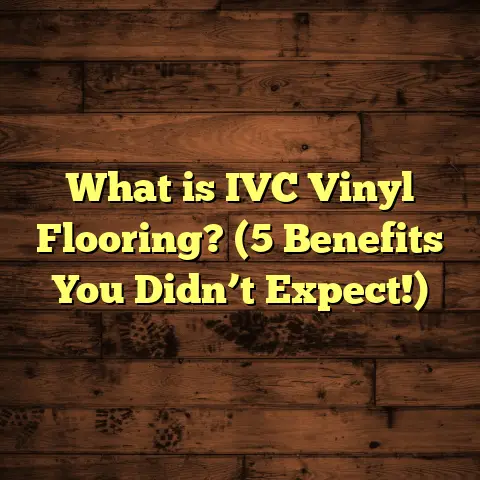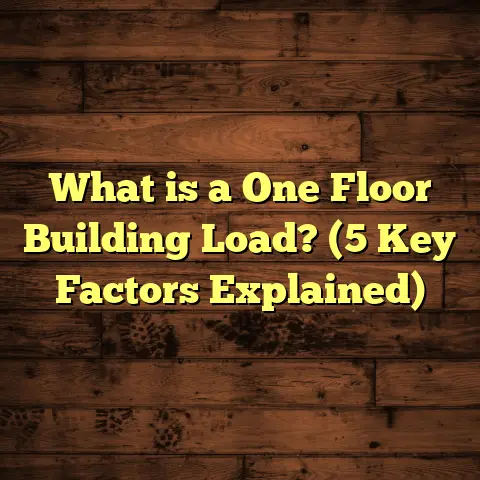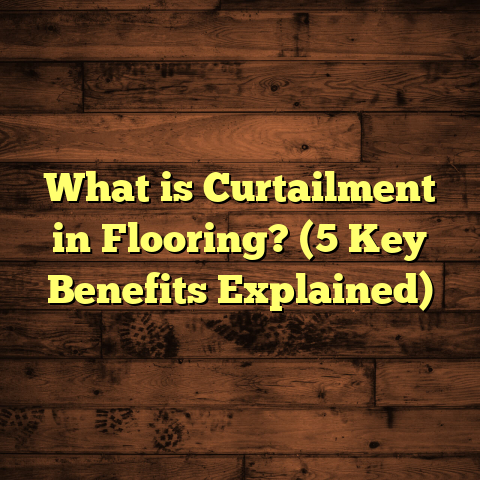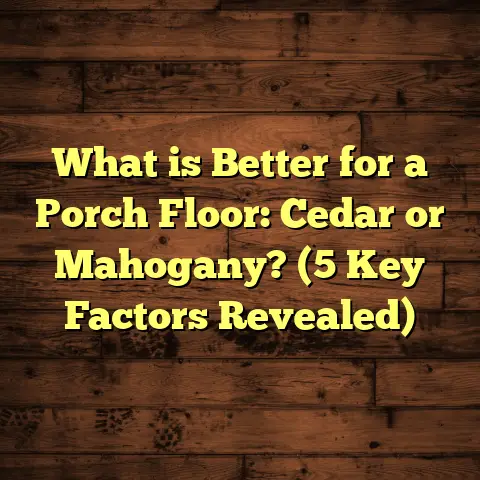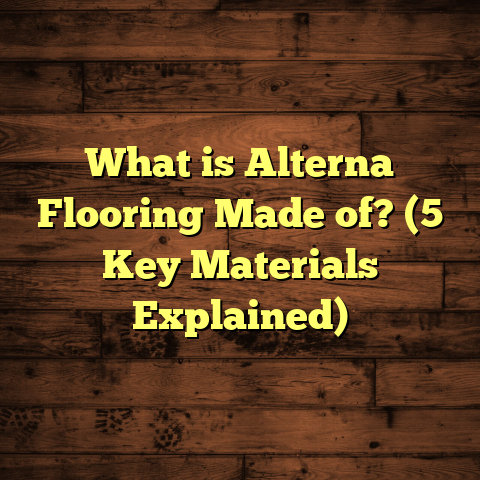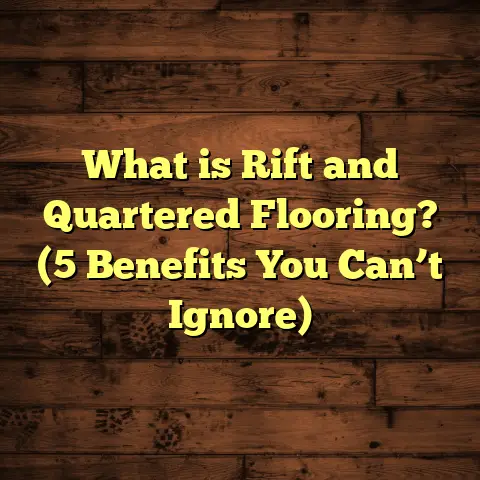What is Vinyl Flooring? (5 Benefits for Modern Homes)
I want to talk about something I’ve seen change the way people think
about flooring over the years: vinyl flooring. It’s become a huge
opportunity for homeowners looking to update their space without
breaking the bank or sacrificing style. If you’ve ever wondered what
vinyl flooring really is or why so many people are choosing it today,
stick with me. I’m going to share everything I know—from what vinyl
flooring actually means, to the benefits I’ve seen firsthand when
installing it, and why it might just be the smart choice for your home.
You might be surprised to learn just how versatile and practical vinyl
flooring can be, especially in modern homes that demand durability,
style, and affordability all at once.
What Is Vinyl Flooring?
To start off simply: vinyl flooring is a synthetic flooring material
made primarily from polyvinyl chloride (PVC), which is a type of plastic.
It’s manufactured into various forms—sheets, planks, or tiles—that
replicate the look of natural surfaces like wood, stone, or ceramic.
But vinyl flooring isn’t just one flat sheet. It’s usually made up of
several layers stacked together:
- Backing Layer: This is the bottom foundation that gives the floor
stability and support. Sometimes it’s made of fiberglass for added strength. - Core Layer: Adds thickness and durability. Depending on the vinyl
type, this can be rigid (like WPC or SPC cores) or flexible. - Design Layer: This is where the magic happens—it’s a printed layer
that mimics textures and colors of natural materials. - Wear Layer: A clear protective coating on top that guards against
scratches, stains, and general wear and tear.
Thickness is an important factor in vinyl flooring’s performance. The
thinner sheets might be around 2mm thick and are often used in commercial
settings or budget residential installs. Luxury vinyl planks (LVP) and
tiles (LVT), which have gained popularity in homes recently, generally
range from 4mm to 8mm thick. The thicker the wear layer (measured in
mils; 1 mil = 0.001 inch), the more durable the floor will be.
For example, a quality LVP with a wear layer of 20 mils or more can last
10-20 years in a busy household. Lower-end products might only have 6-12 mils of wear layer and last 5-7 years before showing signs of wear.
Vinyl flooring can be installed in almost any room—kitchens, bathrooms,
basements, even laundry rooms—because of its resistance to moisture.
That’s something not every flooring material can claim.
In terms of installation timeframes: a professional crew can usually install
vinyl flooring at a rate of 250 to 400 square feet per day depending on
the complexity of the room shape and whether it’s peel-and-stick tile,
click-lock planks, or glued-down sheets. For a standard 1,000 square foot area,
installation typically takes between 2 to 4 days including prep work.
Costs vary widely based on material quality and region but generally look like this:
| Type | Material Cost (per sq ft) | Installation Cost (per sq ft) | Total Cost Range (for 500 sq ft) |
|---|---|---|---|
| Basic Vinyl Sheet | $1.50 – $3 | $1 – $2 | $1,250 – $2,500 |
| Mid-Range LVT/LVP | $3 – $6 | $1.50 – $3 | $2,250 – $4,500 |
| Luxury Vinyl (thickest) | $5 – $8 | $2 – $4 | $3,500 – $6,000 |
Beyond price, one of the things I love about vinyl is how easy it is to maintain and how forgiving it can be with subfloors that aren’t perfect.
Why Vinyl Flooring Stands Out: 5 Benefits I’ve Seen Make It a Winner
Through years of installing floors in hundreds of homes—from rentals to high-end renovations—I’ve found five benefits that really set vinyl apart. These are not just claims manufacturers make; they’re based on what I’ve witnessed on job sites and heard from homeowners who live with vinyl floors every day.
1. You Get Style Without Paying a Fortune
I’m sure you’ve walked into a home or showroom thinking “Wow, that looks like real hardwood” only to find out it’s vinyl. That’s because modern printing technology allows vinyl planks and tiles to have hyper-realistic textures and colors.
One specific project comes to mind. A client wanted the look of white oak but had a budget closer to laminate than hardwood. We chose luxury vinyl planks with an embossed finish that perfectly mimicked wood grain and color variations.
The total cost for materials was about $3.75 per square foot—much cheaper than white oak flooring that would have run over $10 per square foot just for materials. Installation took two days for their 650-square-foot kitchen/dining area.
What really impressed me was how many guests complimented the floor without realizing it wasn’t real wood. For homeowners who want beautiful floors but don’t want to spend thousands more on materials and labor, vinyl is a fantastic middle ground.
In addition to wood looks, there are tons of stone, concrete, and even metallic finishes available today. If you want to get creative with patterns—like herringbone or chevron—vinyl planks are flexible enough to accommodate those designs without extra cost overruns.
2. Durability That Handles Everyday Life Like a Champ
If you have kids, pets, or just a busy household, durability matters big time when picking floors. Vinyl flooring performs exceptionally well here thanks to its wear layer protecting it from scratches and dents.
I recall one family with two young kids who installed vinyl in their entryway and mudroom. After six months of muddy shoes and spilled drinks, the floor looked almost brand new with no visible damage. Their hardwood floors in other rooms showed wear much quicker.
Vinyl also resists staining better than carpet or some wood floors. Many brands offer antimicrobial coatings now as well which add a layer of protection against bacteria—great for homes with allergies or small children.
Commercial-grade vinyl floors often have wear layers up to 30 mils thick and are designed for places like hospitals or schools where heavy foot traffic is constant. Residential luxury vinyl with a wear layer of at least 20 mils provides plenty of durability for most homes.
3. Water Resistance Means No Panic Over Spills or Moisture
One huge advantage I always emphasize is how vinyl stands up to moisture—a common enemy for hardwood or laminate floors.
I once worked on a basement remodel where the client wanted something waterproof but still stylish. We installed waterproof LVT that could take humidity spikes and even occasional water from basement flooding without damage.
This water resistance also makes vinyl great for kitchens and bathrooms where spills happen regularly. Unlike hardwood that can warp or laminate that can swell if water seeps underneath, vinyl remains stable.
Cleaning is easy too: just sweep regularly and mop with damp water—no need for harsh chemicals or waxes like you’d use on other floors.
4. Comfort Underfoot and Noise Reduction
Vinyl doesn’t have the cold hard feel that tile or stone has, nor does it sound hollow like some laminates can when walked on.
I’ve had many clients tell me they stand longer cooking on their vinyl kitchen floors without feeling fatigued because there’s a bit of cushioning between their feet and the subfloor.
Some types of vinyl come with attached underlayment layers that provide extra comfort and absorb sound—this is a great feature in multi-level homes or apartments where noise transfer can be an issue.
5. Design Flexibility for Every Taste
Whether you want rustic farmhouse charm, sleek modern minimalism, or something bold and artistic, vinyl can deliver.
I bring samples to clients all the time so they can see how different patterns work with their cabinets or furniture under natural lighting conditions. The range today includes:
- Wood looks in multiple species: oak, walnut, hickory
- Stone patterns like marble, slate, granite
- Concrete textures for industrial styles
- Abstract or geometric designs for unique spaces
Because vinyl comes in sheets as well as planks and tiles, you can mix patterns too—something that’s tricky with hardwood or ceramic tile without huge costs.
My Approach to Budgeting Vinyl Flooring Projects
One challenge installers face—and homeowners too—is figuring out realistic budgets upfront. I’ve found that using online tools like FloorTally saves me tons of time and frustration when estimating costs.
FloorTally lets me input room dimensions, choose local labor rates for my area (I work mostly in the Pacific Northwest), select specific materials including their thickness and finish type, then factor in waste percentages based on room shape complexity.
For example, last month I planned a project for a 900-square-foot open-concept living-dining-kitchen area using mid-grade luxury vinyl planks:
- Materials cost: $4/sq ft × 900 sq ft = $3,600
- Labor cost: $2/sq ft × 900 sq ft = $1,800
- Waste factor: 7% × 900 sq ft = ~63 sq ft extra × $4 = $252
Total estimate came out to about $5,652 before taxes—right in line with my previous experience on similar jobs.
FloorTally also gives me visual breakdowns so clients can see exactly where their money goes—material vs labor vs waste—which helps set expectations clearly from day one.
A Deep Look at Vinyl Flooring Types
You might wonder if all vinyl flooring is the same. It’s not! Here’s a quick overview based on what I’ve seen in projects:
Sheet Vinyl
Sheet vinyl comes in large rolls typically 6 to 12 feet wide and is glued down over the subfloor.
Pros:
- Seamless installation reduces water seepage risk.
- Usually lowest cost per square foot.
- Wide variety of patterns available.
Cons:
- Tricky to install in rooms with lots of corners.
- Damage can be harder to repair since sheets are large.
- Less realistic texture compared to LVP/LVT.
Luxury Vinyl Planks (LVP)
LVP mimics hardwood planks in size (usually around 6 inches wide by 48 inches long) and thickness (4mm – 8mm).
Pros:
- Click-lock installation means no glue required.
- Realistic textures with embossing.
- Easy replacement of damaged planks individually.
- Water-resistant or waterproof options available.
Cons:
- Slightly more expensive than sheet vinyl.
- Seams between planks visible depending on quality.
Luxury Vinyl Tiles (LVT)
LVT looks like ceramic or stone tiles but is made from vinyl material.
Pros:
- Can be installed with grout lines for authentic tile look.
- Durable with excellent water resistance.
- Easier on feet than real tile.
- Good for kitchens/bathrooms.
Cons:
- Can be pricier than sheet vinyl.
- Some products require glue-down installation which takes longer.
Installation Tips from My Experience
When installing vinyl flooring myself or overseeing crews, these points make all the difference:
- Subfloor Prep is Key: Vinyl needs a smooth clean surface free of bumps or debris. I always check moisture levels especially in basements before starting installation.
- Acclimate Materials: Letting planks or sheets sit in the home environment for at least 48 hours prevents expansion/contraction issues later.
- Use Proper Tools: A good utility knife for sheet vinyl cuts; pull bars and spacers for plank installations.
- Leave Expansion Gaps: Even though vinyl doesn’t move as much as wood, leaving small gaps at walls prevents buckling.
Common Questions I Hear About Vinyl Floors
Q: Can I install vinyl flooring myself?
A: Yes! Many types like peel-and-stick tiles or click-lock LVP are DIY-friendly if you’re handy with basic tools. For glued-down sheets or intricate rooms, professionals might be better.
Q: How long does vinyl flooring last?
A: With proper care, residential luxury vinyl lasts between 10 to 20 years depending on thickness and wear layer. Commercial grades last longer but cost more upfront.
Q: Is vinyl eco-friendly?
A: Vinyl is made from PVC which isn’t biodegradable but many manufacturers have recycling programs now. Look for products labeled phthalate-free or low-VOC for healthier indoor air quality.
Q: Does vinyl fade over time?
A: Direct sunlight over long periods can cause some fading unless UV-resistant options are chosen. Using blinds or curtains helps protect floors near sunny windows.
A Personal Story That Changed My View on Vinyl
Early in my career, I didn’t think much about vinyl flooring—it seemed like a cheap option compared to hardwood or tile. But then I was hired by a family renovating their first home on a tight budget who desperately needed something durable due to kids and pets running around.
We installed mid-range luxury vinyl planks throughout their kitchen and hallway—something I was skeptical about initially because it wasn’t “real wood.” Three years later when I visited them again they raved about how beautiful and easy-to-maintain the floors were. No scratches from pet claws; no warping from spilled drinks; just perfect condition after heavy use.
That experience changed my perspective entirely. Since then, I’ve recommended vinyl floors to dozens of clients who want style plus practical performance without emptying their wallets.
Wrapping Up My Thoughts on Vinyl Flooring
If you’re thinking about updating your floors but feel overwhelmed by options or pricing concerns:
- Vinyl offers excellent value for money compared to hardwood or tile.
- It handles moisture better than many alternatives.
- It’s durable enough for active households.
- Installation times are shorter which reduces disruption.
- Design options are nearly limitless with realistic textures today.
Using tools like FloorTally helps me plan projects clearly so budgets stay realistic from day one—something I encourage anyone remodeling their floors to try out before ordering materials or scheduling installers.
So ask yourself: does your home need something stylish yet practical? If yes—even if you haven’t considered vinyl before—it’s worth giving it a serious look before deciding anything else.
If you want me to help estimate costs or suggest specific products based on your home’s needs just ask—I’m here anytime!
